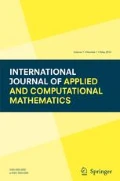Abstract
We present some applications of the generalized trigonometric functions to problems in classical mechanics and to the theory of integral equations. We discuss how second and third order trigonometries are ideally suited tools to treat either damped harmonic oscillators and three dimensional rotational models. We make further progress in the generalization process by discussing the properties of Laguerre trigonometries along with the relevant link with the theory of Bessel functions.
Similar content being viewed by others
Notes
Whenever necessary to emphasize the dependence on the constants \(a,\, b\) we will use the notation \(C(\theta | a,b),\, S(\theta | a,b)\).
The Trig-functions in Eq. (2) are neither even nor odd under parity transformation and it is understood that \(C(-\theta | a,b)=C(\theta | a,-b)\) and \(S(-\theta | a,b) = -S(\theta | a,-b)\).
It is worth noticing that \(e^{n h \theta }=C(n\theta )+h S(n\theta )=\left[ C(\theta )+h S(\theta )\right] ^{n}\), which can be exploited to derive identities mimicking those of the circular (and hyperbolic) trigonometry. Regarding the duplication formulae we find \(e^{2 h \theta }= C^2(\theta )+a S^2(\theta )+ 2h C(\theta )S(\theta )\), eventually providing the second degree trigonometric duplication formula \(C(2\theta ) = C^2(\theta )+a S^2(\theta )\), \(S(2\theta ) = 2 S(\theta )C(\theta )+b S^2(\theta )\).
In the case of the ordinary imaginary unit \(\phi ^*={\varvec{i}}\pi /2\).
For integer \(\nu \), Eq. (48) is nothing but a Cauchy-repeated integral.
It can be expressed in terms of the \(0-th\) order modified Bessel through the identity \({}_l e(\eta )=I_0(2\sqrt{\eta })\).
References
Fjelstad, P., Gal, S.G.: Two-dimensional geometries, topologies, trigonometries and physics generated by complex-type numbers. Adv. Appl. Clifford Algebras 11(1), 81 (2001)
Yamaleev, R.M.: Complex algebras on N-order polynomials and generalizations of trigonometry, oscillator model and Hamilton dynamics. Adv. Appl. Clifford Algebras 15(1), 123 (2005)
Yamaleev, R.M.: Multicomplex algebras on polynomials and generalized Hamilton dynamics. J. Math. Anal. Appl. 322, 815 (2006)
Babusci, D., Dattoli, G., Di Palma, E., Sabia, E.: Complex-type numbers and generalizations of the Euler identity. Adv. Appl. Clifford Algebras 22(2), 271 (2012)
Dattoli, G., Mari, C., Torre, A.: A simplified version of the Cayley–Hamilton theorem and exponential forms of the \(2\times 2\) and \(3\times 3\) matrices. Nuovo Cim. B 108, 61 (1993)
Yamaleev, R.M.: Hyperbolic cosines and sines theorems for the triangle formed by arcs of intersecting semicircles on Euclidean Plane. J. Math. 2013, 1–10 (2013)
Dattoli, G., Del Franco, M.: Hyperbolic and circular trigonometry and application to special relativity. arXiv:1002.4728 [math-ph] (2010)
Yamaleev, R.M.: From generalized Clifford algebras to Nambus formulation of dynamics. Adv. Appl. Clifford Algebras 10(1), 15 (2005)
Dattoli, G., Migliorati, M., Ricci, P.E.: The Eisentein group and the pseudo hyperbolic function. arXiv:1010.1676 [math-ph] (2010)
Ciocci, F., Dattoli, G., Renieri A., Torre, A.: Free electron lasers as insertion devices. In: Insertion Devices for Synchrotron Radiation and Free Electron Laser, pp. 237–286. World Scientific, Singapore (2000)
De Zela, F.: Closed-form expressions for the matrix exponential. Symmetry 6(2), 329 (2014)
Babusci, D., Dattoli, G., Sabia, E.: Operational methods and Lorentz-type equations of motion. J. Phys. Math. 3, 1 (2011)
Cabibbo, N.: Unitary symmetry and leptonic decays. Phys. Rev. Lett. 10, 531 (1963)
Kobayashi, M., Maskawa, T.: CP-violation in the renormalizable theory of weakinteraction. Prog. Theor. Phys. 49, 652 (1973)
Dattoli, G., Zhukovsky, K.: Quark flavour mixing and the exponential form of the Kobayashi-Maskawa matrix. Eur. Phys. J. C 50, 817 (2007)
Dattoli, G., Di Palma, E.: The exponential parameterization of the quark mixing matrix. arXiv:1301.5111 [hep-ph]
Dattoli, G., Di Palma, E., Sabia, E.: Cardan polynomials, Chebyshev exponents, ultra-radicals and generalized imaginary units. Adv. Appl. Clifford Algebras 25(1), 81 (2015)
Penson, K.A., Blasiak, P., Horzela, A., Duchamp, G.H.E., Solomon, A.I.: Laguerre-type derivatives: Dobiński relations and combinatorial identities. J. Math. Phys. 50, 083512 (2009)
Dattoli, G., Mancho, A.M., Quattromini, M., Torre, A.: Exponential operators, generalized polynomials and evolution problems. Radiat. Phys. Chem. 61, 99 (2001)
Acknowledgments
We would like to thank Danilo Babusci and Robert Yamaleev for their kind interest and encouragement in this work.
Author information
Authors and Affiliations
Corresponding author
Appendix
Appendix
In this appendix we will clarify the role and the genesis of the composition rule of Eq. (75).
The Laguerre derivative satisfies the identity
and, accordingly, the pseudo-shift operator \(e^{\hat{c}y {}_l\partial _x}={}_l e(y {}_l \partial _x)\) acting on a monomial \(x^n\) yields
It can now be argued that the composition of Eq. (75) can be considered as the Newton binomial associated with the algebraic structure due to the specific form of the operator \(\hat{c}^{n}\).
According to the previous identities we can also state that
allowing the derivation of the following semi-group property of the l-exponential
In full analogy with the ordinary Euler formula we introduce the l-trigonometric (l-t)-functions through the identity
where the l-t cosine and sine functions are specified by the series
It is easily checked that they satisfy the identities
and therefore the harmonic equation
The use of the properties of the l-exponential function allows the derivation of the following addition theorems for the functions in Eq. (84)
The proof is given below, by observing that
and since
we can equate real and imaginary parts to infer the identities of Eq. (87).
Rights and permissions
About this article
Cite this article
Dattoli, G., Palma, E.D., Nguyen, F. et al. Generalized Trigonometric Functions and Elementary Applications. Int. J. Appl. Comput. Math 3, 445–458 (2017). https://doi.org/10.1007/s40819-016-0168-5
Published:
Issue Date:
DOI: https://doi.org/10.1007/s40819-016-0168-5



